|
The following is based mainly on my researches using the chessgames.com opening explorer and some other internet or book sources. The lines chosen tend to be mainlines and not offbeat moves. However, it's often not today's mainlines, but old mainlines, or rarer moves that are anyway completely playable, even at world championship level. I'm a big advocate of playing the main lines. But I don't want to enter sharp ultra-theorical lines where theory is getting bigger and bigger, like the Slav, or the English attack. However, I think it's still possible to play, for example, the Spanish, without knowing too much theory, if one chooses his lines correctly. Because <comprehension is what makes the difference over the board>. As a general rule, I tried to avoid all unclear lines, where sacrifices are needed to keep the balance, or where the white king is in danger. I like to keep it simple when I have the white pieces. I like principled play. The more important thing is that my repertoire has to be <coherent> and <sound>. I will try to give one or two games for each of black's possible response, with a quick written overview of the plan. Our model players for the collection will be Vasily Smyslov, Efim Geller, Nigel Short, Michael Adams, Paul Keres, Anatoly Karpov and Viswanathan Anand, seven extremely strong positional, classical players. May this repertoire serve you well in your own games,
LibertyJack
------------
I) Open Games <1. ... e5 2. Nf3> a) Ruy Lopez <2... Nc6 3. Bb5> * <3... d6> The <Old Steinitz Defence> No one really plays this defense anymore, because it's too passive and black has almost no chance of winning. See Anand vs G Vescovi, 2004 with wonderful logical play from the World Champion. * <3... Nd4 4. Nxd4 exd4 5. 0-0> <Bird's Defense> Basically they are two lines for black 5... c6 and 5... Bc5. Against both moves white should play Bc4. White has a big space advantage on the kingside and black's development looks akward in every line. Vachier-Lagrave vs D Howell, 2009 and Geller vs Szabo, 1973 model games for white * <3... f5 4. d3> <Schliemann Defence> Here I would recommend the simple and strong d3 move. White enjoys a stable edge. If black plays 4... Nf6, just taking on f5 is strong. Svidler vs Aronian, 2010 is the kind of game one should hope to play as white, with the correct exchanges, and masterful usage of the space advantage. * <3... Bc5 4. c3> <Classical/Cordel Defence> White should take the center under control via this move. If black takes on e4, see Alekhine vs E Baasch, 1912. If black plays the <Cordel Gambit>, follow Anand steps Anand vs K Pulkkinen, 1986 * <3... g6> <Kingside Fianchetto Defence> It is quite a good defence. White should just build up the center and keep pressurizing his opponent as in Kupreichik vs G Ciolac, 1996. I'd recommend not to close up the center as it would give black kind of a King's Indian type of position and that's what he wants. * <3... Nge7 4. Nc3> <Cozio Defence> It is clearly the best move. Either black's king is uncastled because he tries to fianchetto his bishop M Geenen vs A Johannes, 1999 Ganguly vs H Nezad, 2010 Either black is quite passive in a symmetrical position where his passive knight on g6 fails to put any pressure on e4 and allow Nc3-d5 Psakhis vs I Sokolov, 1993 * <3... Nf6 4. O-O Nxe4 5. d4 > <Berlin Defence> The Berlin is known to lead to a draw by force. This reputation is not deserved. It creates very interesting battles where the player with the better understanding of positional and endgame play wins. One can even invent his own ideas in this kind of position and do reasearch. Theory and ideas on it keep evolving, and this is why so many play it. Plus, playing this kind of position improves one's understanding of chess. For the rarer Be7 line, see Adams vs D Howell, 2010. For the mainline Berlin variation, see Caruana vs Eljanov, 2011 and P Carlsson vs M Aboudi, 2011 * <3... a6 4. Ba4 d6 5. 0-0> It's the <Modern Steinitz Defence>. Still very solid, but less passive because black has more choices due to the ... b5 possibility which is always latent. If black tries to hard to get the bishop pair, he wastes too much time and white has the better position. If black tries to trick you by playing ...Bg4 followed by ...h5, the refutation is quite simple: K Spraggett vs S P Sethuraman, 2006 or if Black plays ...Qf6 Geller vs S Soylu, 1988. If black keeps developing, just pressurizing, like Karpov, the <true master of the Ruy Lopez>: Karpov vs Westerinen, 1974 Note the fantastic pawn exchange finesses by Anatoly Karpov. He doesn't retake automatically. Non-sterotypical play is the key to master * <... a6 4. Ba4 Nf6 5. O-O Nxe4 6. d4 b5 7. Bb3 d5 8. dxe5 Be6 9. c3 Bc5 10. Nd2 0-0 11. Bc2 Bf5 12. Nb3> It's my recommendation agains the <Open Defence> as in Karpov vs Korchnoi, 1978 where Karpov places one of his best ever exchange sacrifices * <... a6 4. Ba4 Nf6 5. O-O b5 6. Bb3 Bc5 7. c3 d6 8. a4 Rb8 9. d4 Bb6 10. axb5 axb5 11. Qd3> is our line against the fashionable <Moller Defence>. See Robson vs B Bok, 2010 with a very nice double pawn sacrifice to exploit black's weakened pawn structure * <... a6 4. Ba4 Nf6 5. O-O b5 6. Bb3 Bb7 7. Re1 Bc5 8. c3 d6 9. d4 Bb6 10. Bg5 h6 11. Bh4> It's the <Arkhangelsk Defence>. Black tries to develop his bishops to the better squares available. Sadly for him, it has drawbacks too: less fight for the center, pawn weaknesses. See Karpov vs J L Fernandez Garcia, 1987, with typical Karpovian consolidation at the end. Note the d3 move, and the queenside attack with a4 * <... a6 4. Ba4 Nf6 5. O-O Be7 6. Re1 b5 7. Bb3 d6 8. c3 0-0 9. h3 Bb7 10. d4 Re8 11. Nd2 Bf8 12. Bc2 g6 13. b3> It's the <Flohr System>. Here's a typical squeeze where white conducts a typical queenside attack Karpov vs Balashov, 1976 * <...a6 4. Ba4 Nf6 5. O-O Be7 6. Re1 b5 7. Bb3 d6 8. c3 0-0 9. h3 Na5 10. Bc2 c5 11. d4 Nd7 12. d5 Nb6 13. Nd2 g6 14. b4> is the <Keres Defence>. If you follow this line, you will start your game with an advantage. That how Anand crushed Carlsen using this line: Anand vs Carlsen, 2007. It's always the same reason: more active pieces. * <...a6 4. Ba4 Nf6 5. O-O Be7 6. Re1 b5 7. Bb3 d6 8. c3 0-0 9. h3 h6 10. d4 Re8 11. Nd2 Bf8 12. Nf1 Bb7 13. Ng3> is the less-theorical <Smyslov Defence> Geller vs Portisch, 1967 features a typical Ruy Lopez kingside attack while E Alekseev vs T Sanikidze, 2005 is a complicated more modern 'total fight' where the centre explodes. Note 19. c4, a typical move for the Ruy Lopez, where pawn structures dictates everything ('do not retake automatically') * <a6 4. Ba4 Nf6 5. O-O Be7 6. Re1 b5 7. Bb3 d6 8. c3 0-0 9. h3 Re8 10. d4 Bb7 11. Nd2 Bf8 12. Bc2 g6 13. d5 Nb8 14. b3> is the complex <Zaitsev System>. With our system, black often has iniative on the queenside, but on the other hand white has much more space. See Karpov vs A Beliavsky, 1983 * <a6 4. Ba4 Nf6 5. O-O Be7 6. Re1 b5 7. Bb3 d6 8. c3 O-O 9. h3 Nb8 10. d4 Nbd7 11. Nbd2 Bb7 12. Bc2 Re8 13. Nf1 Bf8 14. Ng3 g6 15. a4> is the strange-looking Breyer Defence. But it is a coherent defence, play becomes very risky. Black may even succeed in pushing d5, but it won't be so easy, and white's better pieces could tell. See the impressive Karpov vs O'Kelly, 1970 ------------
b) Petrov Defence <2... Nf6 3. Nxe5 d6 4. Nf3 Nxe4 5. Nc3> The <Nimzovitch Variation>. White exchanges a potential structural weakness against an open d-file, a space advantage and easy development. If black castles kingside, it might be very dangerous Caruana vs Landa, 2010 which was straightforward but effective. If black castles queenside, other plans are available, like in Leko vs V Gashimov, 2008 (win the bishop pair with 10. h4! followed by a strong attack on the queenside (white has a majority there. ------------
c) Philidor Defence <2... d6 3. d4> It is an interesting opening positionnaly (Nimzovitch played it a lot) but black always lacks of space. * <3... exd4> A very old opening which is rarely played nowadays. Black can either play c5 in Benoni style to liven things up as in T L Petrosian vs R Tischbierek, 2005 or just try to pressurize e5 by normal means like in N Pogonina vs S Zavgorodniy, 2006. * <3... Nf6> The most refined line - the <Hanham Variation>, where black holds a strong point on e5. A manoeuvering game ensues, similar to some modern lines of the Ruy Lopez. It often leads to complicated strategic and tactical games. Follow the steps of Miles vs T Gelashvili, 2000 and Movsesian vs J Pribyl, 1997 * <3... f5> The <Phillidor Counter Gambit, which is rarely played nowadays but tricky. Let's see how to get an advantage out of the opening. To me 4. Nc3! looks like the more principled move and simplest. Sadly there are few examples because this opening is very rare nowadays. T Farley vs J Cueto, 2006 is a correct game but I like c4 more than f3 after which the pawn structure is absolutely symmetrical ------------
d) Offbeat lines
* <2... f5 3. Nxe5 Qf6 4.d4 d6 5.Nc4 fxe4 6.Nc3 Qg6 7.Ne3 ⩲> It the <Latvian Gambit>. This line really seems much better for white, f3, castles queenside, everything comes easily. Against the 3... Nc6 line, white should not enter complications by winning the exchange, but just take on c6 and keep developing. R Pruijssers vs T Kabos, 2008 is a sample game in the mainline * <2... d5 3. exd5 e4 4. Qe2 ⩲> A high level blitz game was played featuring the <Elephant Gambit>. It is quite interesting. White's treatement of the opening is exemplary. Movsesian vs Vachier-Lagrave, 2010 ------------
II) Sicilian Defence <1... c5 2. Nf3> a) <2... d6 3. d4 cxd4 4. Nxd4 Nf6 5. Nc3> * <5... a6 6. Be2> 
click for larger viewIt clearly the best positional line against the <Sicilian Najdorf>. White is heading for a small but stable advantage. In case of ...e5 by black, he will try to exploit the weakness of the d5 square as well as exploiting pawn weakness on the queenside via a4 and possibly a5. The f pawn will either go on f3 to reinforce the e4 pawn or on f4 to improve white's control over the center. If black plays e6, game transposes into our line against the Sheveningen, followed by Be2, Be3, a4, f4, etc. The great specialists of the <Opencesky Variation> are Anatoly Karpov and Efim Geller See Karpov vs Tukmakov, 1971 (the endgame is not always bad for white in the sicilian), Anand vs Kasparov, 1995 (extraordinary powerful queenside and central play by Anand) for <e6, transposing into the Sheveningen>. Against <6... e5>, a textbook example is Karpov vs Quinteros, 1982, using all the thematic motifs of this variation as white. Another plan is with Bf3 and Re1 as played in N Pogonina vs The World, 2009 * <5... Nc6 6. Bg5> 
click for larger viewThe Richter-Rauzer Attack is white's best bet against the <Classical Sicilian>. See Tal vs R Byrne, 1966 for typical ideas and plans. * <5...g6 6. Be3 Bg7 7. f3 O-O 8. Qd2 Nc6 9. Bc4 Bd7 10. O-O-O Rc8 11. Bb3 Ne5 12. Kb1> 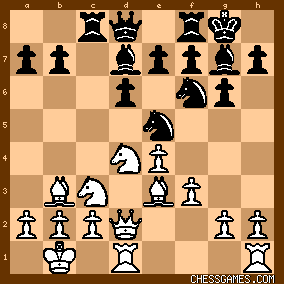
click for larger view Against the ultra-sharp theorical <Dragon Variation>, I like this sweat little king move which takes care of the king before launching the attack on the kingside. It might not be the best but it is certainly less risky than other lines of this opening. See Karpov vs Sosonko, 1987 ------------
b) <2... Nc6 3. Bb5> 
click for larger viewthe <Nyezhmetdinov-Rossolimo Attack>, an excellent positional opening as white, not a creaky Ruy Lopez, as the chess thinkers still believed until more than half a century ago. Reasons for the Bxc6 can vary, and can be counter-intuitive. Often, the justifications for this capture are not only static (pawn structure), but dynamical too (the knight on c6 was attacking many central squares after all) and in certain cases White can gain a advantage in developement too. In many openings, particularly with e4, white fears the endgame, due to bad structure. In the Rossolimo, it's almost never an issue for white. But it's also a very flexible opening from which many structures can arise. This opening often leaves white with many plans available, which means theory is not too developed on it, and that it leaves place to positional creativity. Let's see what white can do against each of blacks main options. * <3... g6 4. Bxc6> Basically white closes the center with d3 and then attacked black's weak structure with the thematic plan combinating Be3, a3 and b4 and dangerous queenside play. Caruana vs V Kuznetsov, 2011 is a typical crush * <3... d6> Here white should keep on developing with 0-0, Re1, c3, Nbd2, etc with a developement à la Ruy Lopez. If black tempts you by playing a6 before you played c3, take the bishop, play d4, and exploit the dynamics. White is better developped and has the more active pieces as in Rublevsky vs M Agopov, 2005. If he plays it after you played c3, white retreats it back to f1 and plays a manoeuvring gain, using his space advantage like here A Sokolov vs S Halkias, 2001 * <3... e6 4. Bxc6 bxc3 5. d3> White takes, seemingly giving black a powerful center. But in the spirit of Nimzovitch, white white will always be able to contest the center via moves like c4, and e5. <Restrain, Blocade, Destroy> as in Anand vs L Christiansen, 1993 ------------
c) <2... Nf6 3. e5 Nd5 4. Nc3> 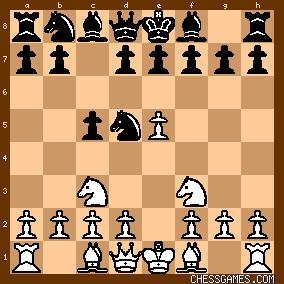
click for larger viewI first thought about avoiding the main line. But why? I was beeing fearful. But fear is what stops patzers like us from becoming IM or GM... Let's try to refute the <Nimzovitch-Rubinstein Sicilian> * <4... e6 5. Nxd5 exd5 6. d4 Nc6 7. dxc5 Bxc6 8. Qxd5 Qb6 9. Bxc4 Bxf2+ 10. Ke2 0-0 11. Rf1 ±> as in P Haba vs H Kummer, 1998 which looked quite convincing. White should be careful though, as it is the most complicated line of the whole system. * <4... Nxc3 5. dxc3> It's not that clear, and not many game have been played in this line. But black's developement look less harmonious than white's, to my eyes. Bc4, Bf5, Qe2 followed by 0-0 look quite a good plan to me as in D Gross vs T Jugelt, 1999 ------------
d) <2... e6 3. d4 cxd4 4. Nxd4 Nf6 5. Nc3 Nc6 6. Nxc6 bxc6 7. e5 Nd5 8. Ne4> 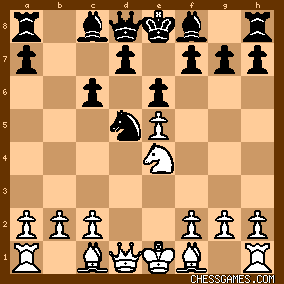
click for larger viewThe exchange variation of the <Four Knights Sicilian> scores heavily for white. White should learn a few lines to get the advantage though, because it can become quite <tactical>. It's the only way to avoid the Shveshnikov which is good for white theoritically. 'Why do I want to avoid the Shveshnikov?' you might ask. Because I find it difficult to get an advantage against, because it is very theorical and because black is extremely dynamic. * <8... Qc7 9. f4 Qb6 10. c4 Bb4+ 11. Ke2 Ba6 12. Kf3 f5 13. Nf2 Ne7 14. Be3 Bc5 15. Bxc5 Qxc5 16. Qd6 ⩲> * <8... f5 9. exf6 Nxf6 10. Nd6+ Bxd6 11. Qxd6 ⩲> * <8... Bb7 9. Be2 c5 10. O-O Qc7 11. c4 ⩲> * <8... Qa5+ 9. c3 f5 10. exf6 Nxf6 11. Nd6+ Bxd6 12. Qxd6 ⩲> ------------
e) <2... e6 3. d4 cxd4 4. Nxd4 Nf6 5. Nc3 Bb4 6. e5 Nd5 7. Bd2 Nxc3 8. bxc3 ±> 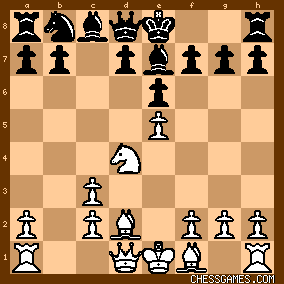
click for larger viewAgainst the rare <Pin Variation>, this is <Kmoch's Variation> which leaves white with an edge, a space advantage, an advanced e pawn and enourmous attacking chances on the kingside with normal developement 0-0, Bd3, Qe2 as in M Al Sayed vs G M Todorovic, 2001. ------------
f) <2... e6 3. d4 cxd4 4. Nxd4> 
click for larger viewBasically white should plan to continue developing with 0-0, Be3, Be2, f4,against the <Paulsen/Kan/Taimanov Systems>. It will either transpose into some Sheveningen style sicilian, either take an independant charachter. For instance, if black plays Bb4, Na4 might be on the cards, to play Nb6 and gain the bishop pair. They are many many many lines but the developement plans are always quite similar for white. The positions that arise are typical sicilian positions, where kingside attack, space advantage, open d-file, potentially weak d5 or f5 square are white's main trump cards. Here are a few lines: * <4... a6 5. Bd3> is the best move, on other moves ... b5! can be annoying. Against the lines with an early ... Bc5, Nb3 is the answer, when a slow positionnal games arise on the board, either with c4 or f4. Short vs Hjartarson, 1991 where black tries to be active and it backfires * <4... Nc6 5. Nc3> Black has many choices but after each of them (be it Qc7, a6, d6), white plays Bd2, Be3, with normal developement. Look at white's piece placement after 12. Rad1! It's splendid Short vs I Miladinovic, 2001. Short vs M Illescas, 1990 is another very instructive game. White let's black take on d3, it strenghtens white's pawn structure and white end up with a better ending. ------------
g) <2... a6 3. c4> The <O'Kelly Variation> where the a6 move has a clear purpose. But on c4, a Maroczy bind structure emerges where the a6 move might prove useless, if not weakening. A example game where Black tried to make use of the vulnerable d4 square too quickly Navara vs I Hausner, 2001 ------------
f) <2... g6 3. d4 exd4 4. Nxd4 Nx6 5. c4> The <Accelerated Fianchetto>, Marcozy Bind Variation. White enjoys a consenquent spacial advantage. Queenside pawnstorming might be on the cards, as well as just keeping pressure, keeping pressure like an old boa. A few themes to be aware of. The potential weakness of white's dark squares (d4 and c5). White should be careful not to loose his strategical iniative. In Ivkov vs G Szilagyi, 1969 black played the interesting <Breyer Variation> and where white won using key themes and impressive endgame technique to win. B Savchenko vs D Szoen, 2005 is interesting too, where central play triumphs over dubious wing manoeuvres. ------------
III) French Defence <1... e6 2. d4 d5 3. Nc3> a) <3... Bb4 4. e5 c5 5. a3> * <5... Bxc3 6. bxc3 Ne7 7. Nf3> 
click for larger viewThe positions are extremely rich positionaly in the <Winawer Variation> and with this line, it becomes <even more> positional. Thematic moves and plans include kingside weaking with h4-h5-h5, dark square attack with a4, Ba3 on the long diagonal, dxc5 to open the game for the bishops and gain the d4 post for the bishop/knight. The lines with Qc7 should transpose as well. I like these lines because they are less abstract than say the Tarrasch with 3. Nd2 and less irrational than the Qg4 lines. Often, sound developement will be a good idea for white as well. For instance, just Bd2, Be2, 0-0, Re1 is a sequence which gives the advantage for white in many lines. In this variation, it's <feeling> that will win the game. A few themes are illustrated in Smyslov vs Uhlmann, 1966 where Smyslov's positional genius tells once again (see comments on the game's page). Short vs Ivanchuk, 1995 is a similar example, where dxc5, tripling the pawn is played. Why. To use the d4 square and open the position for the bishops. Note the rook manoeuvre Rh4, which is thematic. Short vs Timman, 1987, we can see Nigel's deep understanding of the opening, which he plays himself. Short vs Korchnoi, 1987 is another epic game. * <5... Ba4 6. b4 cxb4 7. Nb5> I would follow Anand steps here, not entering the complications black wants after the plausible Qg4 but going for a slow positional massacre on the dark squares: Anand vs Lputian, 2000 ------------
b) <3... Nf6 4. Bg5> 
click for larger view* <4... Be7 5. e5 Nfd7 6. Bxe7> The <Classical French> always creates interesting battles. Almost always with opposite-side castling, the fight can also evolve around the d4 square, and the better minor piece. One can play specificaly against black's bad bishop as in Spassky vs R Borngaesser, 1986. Svidler vs Short, 2002 features the risk of castling kingside for black * <4... Bb4 5. e5 h6 6. Bd2 Bxc3 7. bxc3 Ne4 8. Qg4> The <MacCutcheon Variation>, a very dynamical and unbalanced line. It has some Winawerian characteristics but also has some independant features. Black wants to exploits white's weaks pawns while white want to use his bishop pair and the open lines he has against black's king. White can aim for a different plan, for example to consolidate his center before going for the assault. To protect his pawn can play g6 as in E Berg vs J Wintzer, 2010 or Kf8 as in Leko vs Huebner, 2000 and Leko vs Radjabov, 2003 ------------
c) <3... dxe4 4. Nxe4

click for larger viewA rather boring line at first glance, you might say. But having a space advantage and a free hand on the whole board is what we want out of the opening. And the <Rubinstein Variation> gives it to us! White should take the iniative either on the kingside either in the center and play 0-0, Bd3, Qe2, Ne5 and manoeuvre like a boa-constrictor to strangulate his opponent. Remember that if c5 is played by black, white will always have a very good endgame due to his queenside pawn majority. I'll quote <Phony Benoni>: <Good Evening: I still don't get it; what do GMs and Super-GMs see in 3...dxe4? 'Oh, delightful! I get defend a tedious position with no counterplay for 50 moves with hopes for nothing more than a draw at the end!' If that's how they think, then I *never* 'Thought like a Grandmaster.'> Carlsen vs Short, 2010 is a model game for white. L Bruzon Batista vs H Hamdouchi, 2004 is a transposition when after 4. Bg5, black concedes the center (Burn Variation) ------------
IV) Caro-Kann Defence <1... c6 2. d4 d5 3. Nd2 dxe4 4. Nxe4> a) <4... Nd7 5. Ng3> The Nd7 line - the <Steinitz Variation> is the most refined line of the Caro-Kann defence, a favorite of Karpov. Avoiding the exchange of knights looks like the more principled continuation to me (we have more space, we moved our knight twice, we don't want to waste all this time to finally exchange it). According to Gallagher, this line is completely underestimated by official theory. A positional game arises where white has a space advantage and a comfortable position with many development plans available. For some reason it is called <the Kasparov Attack> Adams vs Karpov, 1994 and Delchev vs M Ori, 2011 are games that should inspire white while playing. ------------
b) <4... Bf5 5. Ng3 Bg6 6. h4 h6 7. Nf3 Nd7 8. h5 Bh7 9. Bd3 Bxd3 10. Qxd3 e6 11. Bd2 Qc7 12. O-O-O Ngf6> 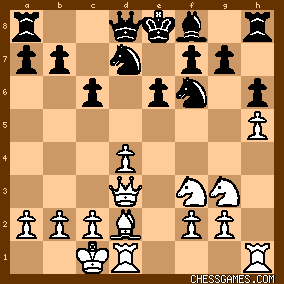
click for larger viewThe Bf5 line - the <Classical Variation> - is extremely solid, and the only for white to win is often in the endgame where his more active pieces could tell, as well as his space advantage. In some lines though, white can try to mount an attack on black's kings via rook lifts or pawn storms. White has to be careful in the endgames, his light squares could become weak, as well as his advanced h5 pawn. Anand vs R Leitao, 2004 and Ponomariov vs W Li, 2001 are nice technical games. If black dares to castle kingside, Nf1 is a very interesting idea as in Robson vs V Malakhatko, 2009 As you just saw, keeping a pair of rook is usual with Re1 instead of Rd1, the occupation of the e5 square is recurrent for white, as well as undermining black's structure with a pawn storm on the kingside. Theses endgames are extremely interesting. ------------
c) <4... Nf6 5. Nxf6+> 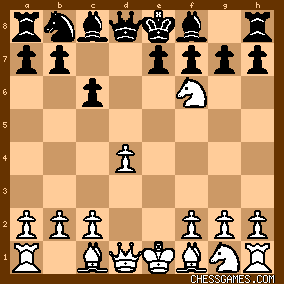
click for larger view* <5... exf6 6. c3 Bd6 7. Bd3 O-O 8. Qc2 Re8+ 9. Ne2> the Smyslov variation where black has a solid position but cannot equalize easily with c5 as it leaves white with a dangerous queenside pawn majority: Plachetka vs J Bellon Lopez, 1987 * <5... gxf6 6. c3 Bf5 7. Nf3 e6 8. g3> The popularity of the once mighty Bronstein-Larsen dropped after the invention of this move which leaves black in a questionable position where dynamic chances should not be underestimated by white, though: Benjamin vs J J Felber, 1993 ------------
V) Pirc Defence <1... d6 2. d4 Nf6 3. Nc3 g6 4. Nf3> 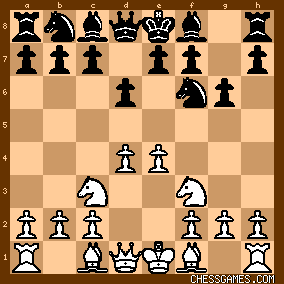
click for larger viewWhite just keeps on developing and any attempt for black to steal the iniative will go nowhere. Pirc players hate the two knights system, because black usually has no counterplay while white enjoys a good space advantage. It is the <soundest> and the simplest system to play as white. a4-a5, h2-h3, Be2, Be3, 0-0 are usual move in this positional system. See Tal vs Quinteros, 1987 where white's better pieces tell and Karpov vs Nunn, 1982, an examplary win where white, I'll quote <Keypusher>: <does nothing flashy but beats a strong GM in 31 moves> ------------
VI) Robatsch Defence <1... g6 2. d4 Bg7> 
click for larger viewThis defence is admitedely quite rare but I thought that covering it might not be a lost of time because they are many positional ideas in this opening, in fact it's one of the most modern openings, and I think that knowing them is necesseray for a complete understanding of chess. Basically, black wants to contest the center. White, if he want to keep it, has to developed his pieces in a harmonious way, otherwise he'll have problems. And black has original ways of attacking it. Raymond Keene is an expert on these methods. Here are several of black tries: a) The Pterodactyl Defence <3. Nc3 c5> J Gallagher vs A Pornariyasombat, 2010 where white just transposed into a Benoni kind of position. Note the sweet and thematic d6 move, to let a piece be on the d5 square b) Pure Robatsch <3. Nc3 c6> where black first wins space on the queenside Adams vs T Lanchava, 2006 is a nice scheme on development for white ------------
VII) Alekhine Defence <1... Nf6 2. e5 Nd5 3. d4 d6 4. Nf3 > 
click for larger viewThe <Alekhine Defence> is an absolute try for black to umbalance the position. For example, in the four pawns attack, precise piece play will stop black from beeing erased by white's pawn mass, and eventually a roughly equal, but chaotic position will emerge. It is the violent, the naive way of meeting this move, but it's also it's critical test. Black has to know his stuff well. But this is intended to be the soundest 1. e4 repertoire available. And the soundest move is clearly developing a piece with 4. Nf3. As the great World Champion Emmanuel Lasker once said: <One or two pawn moves in the opening, no more> It's the <Modern Line>, the soundest and the most logical move available to white. White enjoyes a stable and safe advantage and should seek to restrict black's counterplay, before trying to gain space himself. a) <4... Bg4> It's the main line of the Modern Variation. Here's an absolutely outstanding game by Karpov. Karpov vs Bagirov, 1970 b) <4... dxe5 5. Nxe5> is an interesting try for black. Short vs Vaganian, 1995 Look at the harmony of white's piece placement compare to black c) <4... g6 5. Bc4> where black intends to fianchetto his bishop Short vs Timman, 1991 is an example game every one knows but still, the play of Short is incredible ------------
VIII) Nimzovitch Defence <1... Nc6 2. Nf3> 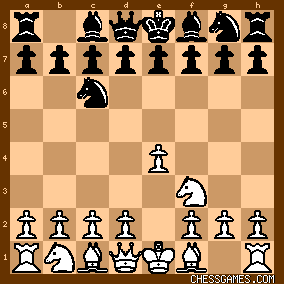
click for larger viewa) <2... d6!?> is probably the best way for black to give the game an independant character but it seems kind of busted too, maybe not if black transposes into the Pirc Defence. Leko vs H Teske, 1995 did not turn out well for black. There are several other tries such as Nf6 (Black equalized really easily in Sax vs B Rogulj, 2007). In fact, best is Be2, which transposes into an offbeat line of the Alekhine Defence: Modern (see Kramnik vs J Cosson, 1999) The Nimzovitch Defence is in my opinion as sound as the Alekhine, if not more. Its lack of popularity is not very understandable. After 2. Nf3 though, black's best option is certainly e5, obviously transposing the open games. ------------
IX) Scandinavian Defence <1... d5 2. exd5> 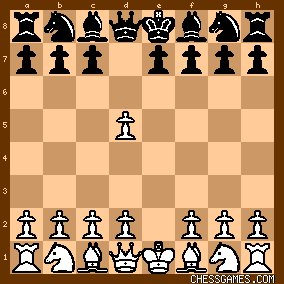
click for larger viewa) <2... Qxd5> is the old way to go, when black has two reasonnable choices after the natural Nc3 move: either Qd6 - <Bronstein's idea> -when the g3 system is considered to be best, either Qa5 when developing with Bc4, Bd2, will give white a good game. Fedorchuk vs D Reinderman, 2005 is a nice game featuring the thematic d5 pseudo pawn sac where black castles queenside with a nice tactical shot at move 24. Bologan vs A Hauchard, 1999 black tries to unbalance the position ends up passive and loses against very nice positional play by Bologan. <When in a doubt, gain space> b) <2... Nf6> is the <Modern Line> after which white should play d4, and after Nxd5, c4, with hypermodern play on the black side. The only way for black to liberate is ...e5, which weakens his kings position. See Bologan vs A Hauchard, 1999
| 


